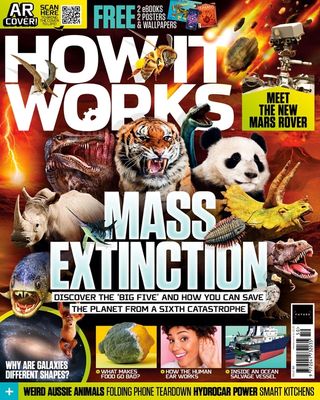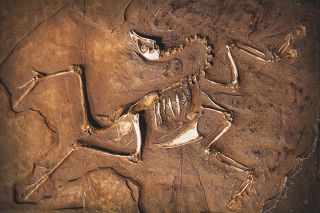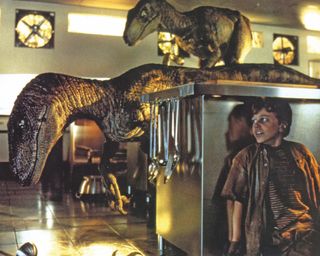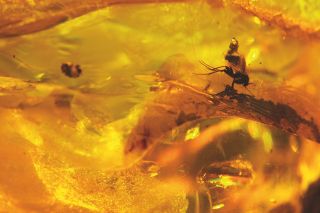Could we build a real-life Jurassic Park?
Advances in science could make it possible to bring the dinosaurs back to life.

Welcome to Jurassic Park. As we open the gates to this zoo of previously extinct creatures, how would you expect the dinosaurs behind them to look? For those who have read or watched "Jurassic Park," the image of a dinosaur may have already been planted in your mind. Your perception might be plagued by the gruesome scenes of park rangers becoming easy meals, or the film's iconic theme tune might resonate in your head as you envision herds of long-necked beasts parading across the land. With great species diversity, the thrill of this dinosaur park cannot be denied. But can a Jurassic Park really happen?
When Michael Crichton first conceived the "Jurassic Park" story in the late 1980s, one of the last things he wrote was perhaps the most significant. How would the scientists in the story obtain the DNA needed to create a theme park of dinosaurs? This would be the key to the entire plot, giving the story a feeling of scientific realism. Eventually, Crichton was inspired by a scientific paper he read, according to an interview with paleobiologist George Poinar, Jr. in an interview with Science Friday.
The paper, published in the journal Science in 1982, referenced a fly that had been found preserved inside hardened tree resin. Somehow, at the end of its life, the fly had ended up submerged in this resin time capsule. This was not just the stroke of genius that led to the creation of this fictional land, but a real-life discovery. Together the story of "Jurassic Park" and the science at the center of the tale would inspire the next generation of paleontologists, opening the world's imagination to dinosaurs.
What might fascinate people most about dinosaurs is the multitude of unanswered questions, with only hints at their dominance before our time. What did dinosaurs really look like, and how did their unique appendages assist them as they scoured the land in diverse groups?

This article is brought to you by How It Works.
How It Works is the action-packed magazine that's bursting with exciting information about the latest advances in science and technology, featuring everything you need to know about how the world around you — and the universe — works.
As humans have never lived alongside dinosaurs, nobody holds the answers to some of the questions. We continue to learn more about dinosaurs as scientists uncover and research more and more fossils. Scientists have now discovered more than 700 dinosaur species worldwide.
Scientists are now working on reversing extinction by bringing animals that vanished from Earth long ago back into our lives. By editing the genetic code in the DNA of extinct animals' closest living relatives, scientists can slowly build backwards and manipulate a model of the species' DNA. One of the most high-profile cases involves the woolly mammoth, which died out around 4,000 years ago. Mammoth DNA is preserved in the frozen soil of Siberia, so scientists are working on a project to combine these fragments of genetic code with that of living elephants. There might be thousands of years separating these species — and over 60 million years for dinosaurs — but if scientists are successful in producing these extinct species, it could be a stepping stone toward the beginning of a true Jurassic Park.
Have we found dinosaur DNA?

The biggest hurdle to overcome before we can create a dinosaur park is how to source the main ingredient. Without access to dinosaur DNA, researchers can't clone true dinosaurs. New fossils are being uncovered from the ground every day. However, while this can provide important evidence of a species' form, its organic material has long since disappeared. Instead of bone, dinosaur fossils consist of rock and sediment that has filled the bone's place. While these clues can tell us about a specimen's shape and size, the time it was alive and any unique features the animal had, they are unable to give us the crucial genetic information.
In 2020, researchers from the U.S. and China discovered cartilage that they believe contains dinosaur DNA, according to a study published in the journal National Service Review. Many paleontologists are skeptical about this claim, as it is widely believed to be impossible for the protein in these molecules to survive for millions of years, according to an article published in The Conversation. The cartilage, from the Hypacrosaurus species of the Cretaceous Period, is over 70 million years old but has been calcified and fossilized, which may have protected the inside of the cells.
Could we create a dinosaur?

So, will it ever be possible to bring a dinosaur back from extinction? It's something that scientists are trying to work out, although the process would be quite different to how it's portrayed in the movies. "We think we have found signals for DNA and that there might be tiny bits left, but not enough to use to make a dinosaur. We can get collagen and some dinosaur proteins, but not all the material we need," paleontologist Jack Horner told How It Works magazine. "If we had the DNA, it would be ridiculous to put it in an ostrich egg. The thing to do would be to grow it in a test tube, because we have no idea how big the embryos of all dinosaurs are. Some dinosaur eggs are the size of ostrich eggs, but for a Tyrannosaur, we think they are a lot longer and they're bigger. It's like thinking about putting a human embryo inside a squirrel."
Horner is the real paleontologist who inspired the character of Alan Grant in "Jurassic Park." Since finding his first dinosaur bone at the age of 8, Horner has dug up the first dinosaur embryos, the first dinosaur eggs in the Western world, and discovered and named the dinosaur species Maiasaura. He was also the palaeontology consultant for the "Jurassic Park" films. And while he deems the cloning process pure fiction, it hasn't stopped Horner from trying to bring back the dinosaurs.

"I actually have a laboratory where we are attempting to figure out how to make a dinosaur," he told How It Works, a sister site of Live Science. "It's called the dino-chicken project, and it's mostly based on genetic engineering. The idea is to use atavistic genes. They are basically ancestral genes, meaning that ancestral animals programmed certain features. For instance, occasionally children are born with extra vertebrae and form a low tail, which the doctor just picks off when the child is born. And every once in a while snakes are born with little appendages."
Horner's plan is to take advantage of these atavistic genes. "I was hoping that some of the features of a dinosaur were atavistic in a bird. All bird species are related to one another, with one common ancestor — dinosaurs — so any bird should work. Chickens are the easiest thing to get eggs from, so I built a laboratory, hired some geneticists and developmental biologists and started seeing if we could find some of these potential atavistic genes," he said.
"We've been working on the tail, mostly, because that seems to be the hardest part," he added. "We discovered that the reduction of the tail from long-tail dinosaur to a short-tail bird is not an atavistic gene. We are trying to figure out how the tail actually works and reverse the process that formed the short tail."
So, are we any closer to making a dinosaur? "Other laboratories have looked at the face, teeth, arms and hands. I think we can do pretty much all the rest of the body. We have the potential of making an animal that has a dinosaur-like head, probably with teeth in it, and we certainly have the capability of reversing the wings to make arms and hands. We know we can do that, but right now we're just trying to fix the tail," Horner said.
Living with dinosaurs

If humans did succeed in bringing dinosaurs back from extinction, how would we coexist? If dinosaurs hadn't gone extinct, humans are unlikely to have been able to evolve. During the 150 million years that dinosaurs existed, mammals lived alongside them, but these animals were nocturnal and lived in burrows. This suggests that this was the only way for mammals to thrive alongside dinosaurs, emerging mainly at night to hunt. Because our lives are completely separate to that of dinosaurs, there's no way of knowing what would happen if dinosaurs were to live on the same land as us.
By observing human behavior with today's large predators, it seems unlikely that the two species would live naturally together. Humans take up so much space on the planet that introducing predators like dinosaurs outside of captivity would likely result in a battle for land.
Horner, however, has a different view. “People always say, 'Where are you going to put these dinosaurs when you make them?' and I always say that many thousands of years ago we started with wolves, and now we have chihuahuas,” he said. “Dogs are basically wolves, and we don't really have to contain them. I wouldn't expect dino-chickens to be the same as the dinosaurs in “Jurassic Park.” They're going to be domestic animals that we don't have to worry about. If you were cloning a real Tyrannosaur, you would have to worry about containing them. Dogs and cats were wild, but now we don't have to contain them — not to the point of making a park anyway.”
Even if the problem of recreating a dinosaur was overcome, could we keep them alive? Some studies of air trapped in amber show that its composition during the Cretaceous Period may have been 35% oxygen, as opposed to 21% today, according to New Scientist. However, during the dinosaurs' extended time on the planet, this number is believed to have varied substantially. Some species would therefore be better suited to our air than others.

It's also been determined that when dinosaurs roamed the Earth, the global temperature would have been much higher than it is today, according to the National Oceanic and Atmospheric Administration. An island in a tropical region of the globe would be the best bet to provide temperatures that many dinosaurs would be comfortable living in.
And as far as containing them is concerned, the park would need to look quite different to how it appears in the film. “If you really, seriously want to build a Jurassic Park and are not just making a movie, you want walls around the dinosaurs to keep them in.” Horner told How It Works. “Reinforced concrete is going to work a lot better than electric fences, because electricity can go out. Electric fences were not a very good idea.”
Sign up for the Live Science daily newsletter now
Get the world’s most fascinating discoveries delivered straight to your inbox.

Ailsa is a staff writer for How It Works magazine, where she writes science, technology, history, space and environment features. Based in the U.K., she graduated from the University of Stirling with a BA (Hons) journalism degree. Previously, Ailsa has written for Cardiff Times magazine, Psychology Now and numerous science bookazines. Ailsa's interest in the environment also lies outside of writing, as she has worked alongside Operation Wallacea conducting rainforest and ocean conservation research.
